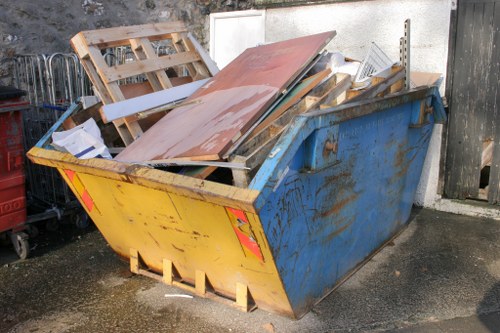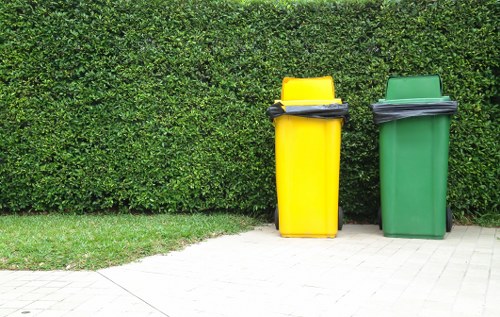Comprehensive Guide to Demolition Waste Removal in Sanderstead
Understanding Demolition Waste

Demolition projects, whether commercial or residential, inevitably generate a significant amount of waste. **Proper demolition waste removal in Sanderstead** is essential not only for maintaining a clean environment but also for ensuring compliance with local regulations. Understanding the types of waste produced and the best practices for their disposal can streamline the demolition process and minimize environmental impact.
Common materials generated during demolition include concrete, bricks, metals, wood, and hazardous substances like asbestos. Each type requires specific handling techniques to ensure safe and efficient removal. Effective waste management can also result in cost savings by recycling and reusing materials wherever possible.
In Sanderstead, local authorities have established guidelines to manage demolition waste effectively. Adhering to these regulations helps prevent legal complications and promotes sustainable practices within the community.
Importance of Professional Demolition Waste Removal

Engaging professional demolition waste removal services in Sanderstead ensures that the process is handled efficiently and safely. Experts possess the knowledge and equipment necessary to manage various waste materials appropriately, reducing the risk of accidents and environmental contamination.
Professional services also streamline the removal process by providing timely collection and transportation of waste. This efficiency minimizes disruptions to your project timeline and helps maintain a clean and organized worksite.
Moreover, professionals are well-versed in local disposal regulations, ensuring that all waste is handled in compliance with Sanderstead’s legal requirements. This adherence not only avoids potential fines but also supports the community’s sustainability goals.
Steps Involved in Demolition Waste Removal

The process of demolition waste removal involves several critical steps:
- Assessment: Evaluating the site to identify the types and quantities of waste generated.
- Segregation: Sorting waste into categories such as recyclable materials, hazardous waste, and general refuse.
- Collection: Gathering the sorted waste using appropriate containers and handling methods.
- Transportation: Moving the collected waste to designated disposal or recycling facilities.
- Disposal: Ensuring that waste is disposed of in accordance with local regulations and environmental standards.
Each step requires meticulous planning and execution to ensure the effectiveness of the waste removal process. Professional services often employ advanced technologies and methodologies to enhance each stage, resulting in optimized waste management.
Recycling and Reuse Opportunities

Recycling and reusing materials from demolition projects can significantly reduce the environmental impact and lower disposal costs. In Sanderstead, there are numerous facilities dedicated to processing recyclable materials such as metals, wood, and concrete.
Metal recycling is particularly effective, as metals retain their value and can be repurposed for various construction projects. Similarly, wood can be reused in landscaping or as a resource for new building materials.
Concrete and bricks can be crushed and utilized as aggregate in new construction, reducing the need for virgin materials. By partnering with local recycling centers, demolition projects in Sanderstead can contribute to sustainable building practices.
Environmental Benefits of Proper Waste Removal

Effective demolition waste removal offers numerous environmental benefits. It minimizes the amount of waste sent to landfills, conserving valuable land space and reducing greenhouse gas emissions associated with waste decomposition.
Proper handling of hazardous materials prevents soil and water contamination, safeguarding the local ecosystem and public health. Additionally, recycling materials reduces the demand for new resources, supporting the conservation of natural habitats and biodiversity.
By implementing responsible waste management practices, demolition projects in Sanderstead can play a pivotal role in promoting environmental sustainability and fostering a healthier community.
Choosing the Right Demolition Waste Removal Service
Selecting a reputable demolition waste removal service in Sanderstead is crucial for the success of your project. Here are key factors to consider:
- Licensing and Certification: Ensure the service provider is licensed and adheres to local regulations.
- Experience: Look for companies with a proven track record in managing demolition waste.
- Comprehensive Services: Choose a provider that offers a full range of services, including assessment, segregation, and disposal.
- Environmental Commitment: Opt for services that prioritize recycling and sustainable practices.
- Customer Reviews: Check testimonials and reviews to gauge the quality of service.
Taking the time to evaluate these factors will help you partner with a service that meets your project’s specific needs and ensures efficient waste management.
Cost Considerations
The cost of demolition waste removal in Sanderstead varies based on several factors, including the volume of waste, the types of materials involved, and the complexity of the project.
Recyclable materials may lower overall costs due to potential resale value or reduced disposal fees. Conversely, handling hazardous waste can increase expenses due to the need for specialized disposal methods.
Obtaining detailed quotes from multiple service providers and understanding their pricing structures can help you budget effectively. Transparency in costs ensures there are no hidden fees and that you receive value for the services rendered.
Regulatory Compliance
Adhering to local regulations is paramount in demolition waste removal. Sanderstead has specific guidelines that dictate how different types of waste should be managed and disposed of.
Non-compliance can result in significant fines and legal repercussions, highlighting the importance of partnering with professionals who are well-versed in these regulations. Compliance not only ensures legal protection but also upholds community standards for environmental stewardship.
Staying informed about any updates or changes to local waste management laws is also beneficial, allowing you to adapt your practices accordingly and maintain adherence to the highest standards.
Safety Considerations
Safety is a critical aspect of demolition waste removal. Improper handling of debris can lead to accidents, injuries, and long-term health issues, especially when dealing with hazardous materials.
Professional waste removal services implement stringent safety protocols to protect workers and the surrounding community. This includes the use of personal protective equipment (PPE), proper training, and safety audits to identify and mitigate potential hazards.
Ensuring a safe demolition site not only preserves the well-being of all stakeholders but also maintains the integrity and reputation of your project.
Sustainable Practices in Demolition
Incorporating sustainable practices in demolition waste removal benefits both the environment and your project’s overall efficiency. Strategies such as waste minimization, material recycling, and energy-efficient processes contribute to sustainability.
Waste minimization involves planning the demolition process to generate the least amount of waste possible. This can be achieved through selective demolition techniques that preserve reusable materials.
Implementing material recycling ensures that valuable resources are recovered and repurposed, reducing the need for new raw materials and lowering the project’s carbon footprint.
Case Studies: Successful Demolition Waste Removal in Sanderstead
Numerous projects in Sanderstead have successfully implemented effective demolition waste removal strategies. For example, a recent commercial demolition project achieved a 70% recycling rate by partnering with local recycling facilities.
Another case involved the safe removal and disposal of asbestos-containing materials, ensuring compliance with safety standards and protecting the community from potential health hazards.
These case studies demonstrate the benefits of professional waste removal services and highlight best practices that can be emulated in future projects.
Future Trends in Demolition Waste Management
The field of demolition waste removal is continuously evolving, with emerging trends aimed at enhancing sustainability and efficiency. Innovations such as advanced recycling technologies and automated waste sorting systems are set to revolutionize the industry.
Additionally, increased emphasis on circular economy principles encourages the reuse and repurposing of materials, further reducing waste and conserving resources.
Staying abreast of these trends allows service providers and clients to adopt cutting-edge practices, ensuring that demolition waste removal in Sanderstead remains environmentally responsible and economically viable.
Conclusion
Effective demolition waste removal in Sanderstead is a multifaceted process that requires careful planning, adherence to regulations, and a commitment to sustainability. By engaging professional services, implementing best practices, and staying informed about industry trends, you can ensure that your demolition project is both successful and environmentally responsible.
Contact us today to learn more about our demolition waste removal services and how we can assist you in managing your next project efficiently.
Don’t let demolition debris overwhelm your project. Book your service now and take the first step towards a cleaner, safer, and more sustainable environment.